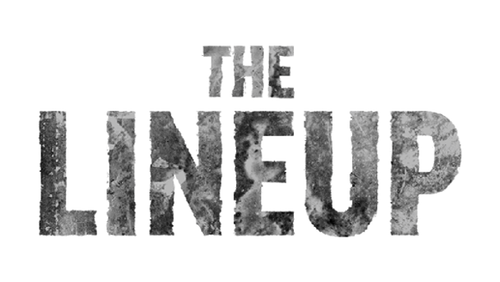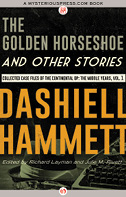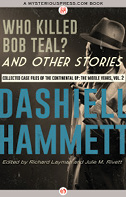Read Who Killed Bob Teal? and Other Stories Online
Authors: Dashiell Hammett
Who Killed Bob Teal? and Other Stories (15 page)

Pat hung fire, thumb still to chin.
“Remember,” I urged him, “it's not only Miss Banbrock we're doing this for. It's a couple of dead ones, and a flock of live ones, who certainly got mixed up with Hador of their own accords, but who don't stop being human beings on that account.”
Pat shook his head stubbornly.
“I'm sorry,” I told the girl with faked hopelessness. “I've done all I can, but it's a lot to ask of Reddy. I don't know that I blame him for being afraid to take a chance onâ”
Pat is Irish.
“Don't be so damned quick to fly off,” he snapped at me, cutting short my hypocrisy. “But why do I have to be the one that shot this Hador? Why not you?”
I had him!
“Because,” I explained, “you're a bull and I'm not. There'll be less chance of a slip-up if he was shot by a bona fide, star-wearing, flat-footed officer of the peace. I killed most of those birds upstairs. You ought to do something to show you were here.”
That was only part of the truth. My idea was that if Pat took the credit, he couldn't very well ease himself out afterward, no matter what happened. Pat's a right guy, and I'd trust him anywhereâbut you can trust a man just as easily if you have him sewed up.
Pat grumbled and shook his head, but:
“I'm ruining myself, I don't doubt,” he growled, “but I'll do it, this once.”
“Attaboy!” I went over to pick up the girl's hat from the corner in which it lay. “I'll wait here until you come back from turning her over to Dick.” I gave the girl her hat and orders together. “You go to your home with the man Reddy turns you over to. Stay there until I come, which will be as soon as I can make it. Don't tell anybody anything, except that I told you to keep quiet. That includes your father. Tell him I told you not to tell him even where you saw me. Got it?”
“Yes, and Iâ”
Gratitude is nice to think about afterward, but it takes time when there's work to be done.
“Get going, Pat!”
They went.
XI
As soon as I was alone with the dead man I stepped over him and knelt in front of the safe, pushing letters and papers away, hunting for photographs. None was in sight. One compartment of the safe was locked.
I frisked the corpse. No key. The locked compartment wasn't very strong, but neither am I the best safe-burglar in the West. It took me a while to get into it.
What I wanted was there. A thick sheaf of negatives. A stack of printsâhalf a hundred of them.
I started to run through them, hunting for the Banbrock girls' pictures. I wanted to have them pocketed before Pat came back. I didn't know how much farther he would let me go.
Luck was against meâand the time I had wasted getting into the compartment. He was back before I had got past the sixth print in the stack. Those six had beenâpretty bad.
“Well, that's done,” Pat growled at me as he came into the room. “Dick's got her. Elwood is dead, and so is the only one of the negroes I saw upstairs. Everybody else seems to have beat it. No bulls have shownâso I put in a call for a wagonful.”
I stood up, holding the sheaf of negatives in one hand, the prints in the other.
“What's all that?” he asked.
I went after him again.
“Photographs. You've just done me a big favor, Pat, and I'm not hoggish enough to ask another. But I'm going to put something in front of you, Pat. I'll give you the lay, and you can name it.
“These”âI waved the pictures at himâ“are Hador's meal-ticketsâthe photos he was either collecting on or planning to collect on. They're photographs of people, Pat, mostly women and girls, and some of them are pretty rotten.
“If tomorrow's papers say that a flock of photos were found in this house after the fireworks, there's going to be a fat suicide-list in the next day's papers, and a fatter list of disappearances. If the papers say nothing about the photos, the lists may be a little smaller, but not much. Some of the people whose pictures are here know they are here. They will expect the police to come hunting for them. We know this much about the photographsâtwo women have killed themselves to get away from them. This is an armful of stuff that can dynamite a lot of people, Pat, and a lot of familiesâno matter which of those two ways the papers read.
“But, suppose, Pat, the papers say that just before you shot Hador he succeeded in burning a lot of pictures and papers, burning them beyond recognition. Isn't it likely, then, that there won't be any suicides? That some of the disappearances of recent months may clear themselves up? There she is, Patâyou name it.”
Looking back, it seems to me I had come a lot nearer being eloquent than ever before in my life.
But Pat didn't applaud.
He cursed me. He cursed me thoroughly, bitterly, and with an amount of feeling that told me I had won another point in my little game. He called me more things than I ever listened to before from a man who was built of meat and bone, and who therefore could be smacked.
When he was through, we carried the papers and photographs and a small book of addresses we found in the safe into the next room, and fed them to the little round iron stove there. The last of them was ash before we heard the police overhead.
“That's absolutely all!” Pat declared when we got up from our work. “Don't ever ask me to do anything else for you if you live to be a thousand.”
“That's absolutely all,” I echoed.
I
like
Pat. He is a right guy. The sixth photograph in the stack had been of his wifeâthe coffee importer's reckless, hot-eyed daughter.
About the Author
Dashiell Hammett (1894â1961) charted a gritty new direction for American crime fiction, crafting true-to-life stories as brash as they are exacting. In 1922, he began writing fiction based on his experience as a private detective, and he pioneered the tough-minded, action-heavy, realistic style that became known as hardboiled. Among his best-known works are
Red Harvest
(1929),
The Maltese Falcon
(1930),
The Glass Key
(1931),
The Thin Man
(1934), and the Collected Case Files of the Continental Op, most of which were published in
Black Mask
magazine.
All rights reserved, including without limitation the right to reproduce this ebook or any portion thereof in any form or by any means, whether electronic or mechanical, now known or hereinafter invented, without the express written permission of the publisher.
These are works of fiction. Names, characters, places, events, and incidents either are the product of the author's imagination or are used fictitiously. Any resemblance to actual persons, living or dead, businesses, companies, events, or locales is entirely coincidental.
“Foreword” Copyright © 2016 by Julie M. Rivett; “Introduction” Copyright © 2016 by Richard Layman; “Who Killed Bob Teal?” Copyright © 1924 by Dashiell Hammett, renewed; “The Whosis Kid” and “The Scorched Face” Copyright © 1925 by Pro-Distributors; renewed by Pro-Distributors as agent for Dashiell Hammett, whose interest was conveyed by will in 1984 to the Dashiell Hammett Literary Property Trust. All Rights Reserved.
Cover design by Jamie Keenan
978-1-5040-3599-6
Published in 2016 by MysteriousPress.com/Open Road Integrated Media, Inc.
180 Maiden Lane
New York, NY 10038


FRESH EBOOK DEALS, DELIVERED DAILY
BE THE FIRST TO KNOWâ
NEW DEALS HATCH EVERY DAY!

Delivered to Your Inbox
Get chilling stories of
true crime, mystery, horror,
and the paranormal,
twice a week.
FROM MYSTERIOUSPRESS.COM
AND OPEN ROAD MEDIA







